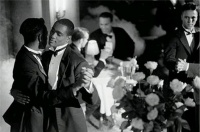LGBTQ Participation in the Harlem Renaissance
The Harlem Renaissance was a movement and its collection of artistic, intellectual, and cultural black Americans that was centred in Harlem, New York City in the 1920s and 1930s. It represented a new, confident, and vibrant soul of Negro expression and self determination for its community. Many of its leaders and prominent members were LGBTQ individuals.
The prominence of its members and the popularity of their artistic output is credited as being the spark that led to the emergence of the black arts community in America. Members included artists, poets, writers, photographers, magazine editors, entertainers, intellectuals, and sculptors.
Much of their work revealed the reality of black American ghetto life. There was some concern that this harsh realism would hinder the advancement of racial equality, but the success and popular profile of the group generally put these concerns to rest. In this regard, the Harlem Renaissance became more than just an artistic movement – it also created a sense of racial pride in its own community which helped to advance the new civil rights agenda.
This period in history was a boom time for American itself. This contributed to a general migration of talented blacks from the South, and immigration from countries such as Jamaica, which took advantage of the economic boom of the North. Harlem saw a net migration of 175,000 African Americans at the time.
The LGBTQ community actively participated in this growth, though not necessarily in terms of prominent public visibility. In June 2010, Harlem saw its first Pride event. The locale’s transgender community was particularly active during the Harlem Renaissance and held many drag ball extravaganzas. Black gays were considered at the centre of the racial gentrification of Harlem during this time.
These gay individuals included the writer of the first novel written by a black person to be a best-selling book – ‘Home To Harlem’ (1928) by Claude McKay. In fact, it was the success of this book that inaugurated the term Harlem Renaissance itself, and many members of the movement coalesced around him. The dean of the Harlem Renaissance, gay academic Alain Locke, was the first African American to receive a Rhodes Scholarship
Also included in the group was lesbian poet Alice Dunbar Nelson. Her home, Dunbar House, was the first national memorial in America to honour an African American individual and is now a museum.
We have identified the following LGBTQ individuals as important participants in the Harlem Renaissance:
- Richmond Barthe, sculptor
- Gladys Bentley, entertainer
- Countee Cullen, poet, editor
- Beauford Delaney, artist
- Angelina Weld Grimke, writer
- Mabel Hampton, activist
- Langston Hughes, poet
- Alberta Hunter, entertainer
- Alain Locke, academic
- Claude McKay, writer
- Alice Dunbar Nelson, poet, civil rights activist
- Richard Bruce Nugent, writer
- Ma Rainey, entertainer
- Bessie Smith, entertainer
- Wallace Thurman, author, magazine editor
- Carl Van Vechten, author, photographer

